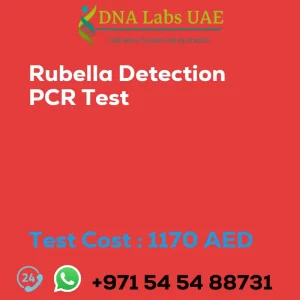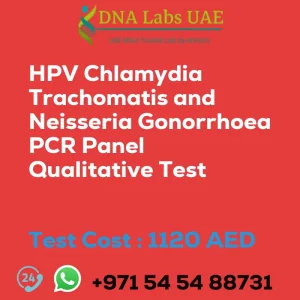HSV 1 and 2 DNA Detection RNA Detection Qualitative Test
Cost: AED 1090.0
Test Details
The HSV 1 & 2 DNA Detection RNA Detection Qualitative Test is a diagnostic test used to detect the presence of herpes simplex virus types 1 and 2 in a patient’s sample. It utilizes DNA or RNA detection methods to identify the genetic material of the virus. This test is typically performed on samples such as blood, swabs from genital or oral lesions, or cerebrospinal fluid.
The DNA or RNA is extracted from the sample and amplified using a technique called polymerase chain reaction (PCR). PCR amplifies the viral genetic material, making it easier to detect and identify. The test then uses specific primers or probes that target the DNA or RNA sequences of HSV 1 and 2. If the virus is present in the sample, the primers or probes will bind to the viral genetic material, producing a positive result.
A qualitative test means that it provides a simple “yes” or “no” answer, indicating the presence or absence of the virus. It does not quantify the amount of virus in the sample or provide information about the stage of infection.
The HSV 1 & 2 DNA Detection RNA Detection Qualitative Test is commonly used in the diagnosis of herpes infections, especially when symptoms are present. It is highly sensitive and specific, meaning it can accurately detect the presence of HSV 1 and 2. It is important to note that this test cannot differentiate between HSV 1 and HSV 2. For this purpose, a separate test called a type-specific serology test may be required.
Components
- Price: 1090.0 AED
- Sample Condition: Whole Blood, Serum, Plasma, C.S.F, Genital swabs
Report Delivery
- 3rd Working Day Email: 36 hours
- On phone: 24 hours
Method
Real Time PCR
Test Type
Viral
Doctor
Physician
Test Department
Genetics
Pre Test Information
Need to sign Consent document and bring any clinical history of patient for HSV 1 & 2 DNA Detection RNA Detection Qualitative Test
| Test Name | HSV 1 and 2 DNA Detection RNA Detection Qualitative Test |
|---|---|
| Components | |
| Price | 1090.0 AED |
| Sample Condition | Whole Blood, Serum, Plasma, C.S.F, Genital swabs |
| Report Delivery | 3rd Working Day Email:-36 hours.On phone: 24 hours |
| Method | Real Time PCR |
| Test type | Viral |
| Doctor | Physician |
| Test Department: | Genetics |
| Pre Test Information | Need to sign Consent document and bring any clinical history of patient forHSV 1 & 2 (DNA Detection) (RNA Detection) QualitativeTest |
| Test Details |
The HSV 1 & 2 (DNA Detection) (RNA Detection) Qualitative Test is a diagnostic test used to detect the presence of herpes simplex virus types 1 and 2 in a patient’s sample. It utilizes DNA or RNA detection methods to identify the genetic material of the virus. This test is typically performed on samples such as blood, swabs from genital or oral lesions, or cerebrospinal fluid. The DNA or RNA is extracted from the sample and amplified using a technique called polymerase chain reaction (PCR). PCR amplifies the viral genetic material, making it easier to detect and identify. The test then uses specific primers or probes that target the DNA or RNA sequences of HSV 1 and 2. If the virus is present in the sample, the primers or probes will bind to the viral genetic material, producing a positive result. A qualitative test means that it provides a simple “yes” or “no” answer, indicating the presence or absence of the virus. It does not quantify the amount of virus in the sample or provide information about the stage of infection. The HSV 1 & 2 (DNA Detection) (RNA Detection) Qualitative Test is commonly used in the diagnosis of herpes infections, especially when symptoms are present. It is highly sensitive and specific, meaning it can accurately detect the presence of HSV 1 and 2. It is important to note that this test cannot differentiate between HSV 1 and HSV 2. For this purpose, a separate test called a type-specific serology test may be required. Overall, the HSV 1 & 2 (DNA Detection) (RNA Detection) Qualitative Test is a valuable tool in the diagnosis of herpes infections, allowing healthcare providers to accurately identify the presence of the virus and provide appropriate treatment and counseling. |








